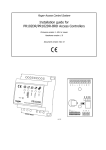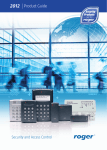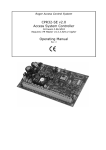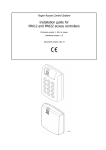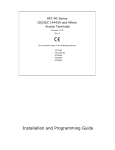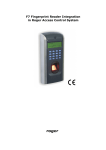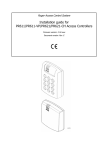Download RFT1000 User Manual Rev.C
Transcript
Roger Access Control System RFT1000 reader User Manual Firmware version: 1.2 or newer Hardware version: 1.1 Document version: rev. C Contents 1. Introduction ................................................................................................................. 3 1.1 This manual ..................................................................................................................... 3 2. Description and Specification ...................................................................................... 3 3. Installation .................................................................................................................. 4 3.1 3.2 3.3 3.4 3.5 3.6 Terminals and connection diagram ..................................................................................... 4 LED indicators .................................................................................................................. 7 Power supply ................................................................................................................... 7 Inputs ............................................................................................................................. 7 Wall mounting .................................................................................................................. 8 Use/installation guidelines ................................................................................................. 9 4. Configuration ............................................................................................................... 9 4.1 Configuration by means of RogerVDM .............................................................................. 10 4.1.1 4.1.2 4.1.3 4.1.4 Connection and communication parameters ................................................................. 10 Connection with controller .......................................................................................... 11 Recognition modes .................................................................................................... 11 Inputs ....................................................................................................................... 12 4.2 Configuration by means of PR Master software ................................................................. 13 4.2.1 4.2.2 4.2.3 4.2.4 4.2.5 Selection of reader type and recognition mode ............................................................. 13 Connection with RFT1000 reader................................................................................. 14 Users ........................................................................................................................ 14 Enrolment of users with fingerprint templates in reader memory (1:N mode) .................. 15 Enrolment of users with fingerprint templates on MIFARE cards (1:1 mode).................... 16 4.3 User identification........................................................................................................... 17 4.4 Card code ...................................................................................................................... 18 4.4.1 SSN code programming .............................................................................................. 18 4.5 Encrypted communication ............................................................................................... 18 4.6 Full memory reset .......................................................................................................... 19 4.7 Firmware update ............................................................................................................ 19 5. Ordering information ................................................................................................. 20 6. Product history .......................................................................................................... 20 Page 2 of 20 1. INTRODUCTION 1.1 This manual This manual contains minimum information that is necessary to properly install and configure RFT1000 readers in RACS 4 access control system. Additional information on RACS 4 system can be found in following documents, which are available at www.roger.pl: · PRxx2 series controllers, Functional description and programming guide · PR Master User manual Whereas use of RFT1000 reader beyond RACS 4 system, in any application requiring identification of users by means of fingerprints and/or MIFARE® proximity cards is described in the document RFT1000 Integration Manual, which is also available at www.roger.pl. 2. DESCRIPTION AND SPECIFICATION RFT1000 biometric reader operates as terminal for PR series controller and is equipped with both fingerprint scanner and MIFARE Ultraligth/Classic proximity card reader. Initial configuration of RFT1000 reader is performed by means of RogerVDM software through Ethernet port, while further configuration and use is performed by PR Master software. The communication between the reader and RogerVDM/PR Master software is encrypted with AES128 CBC standard. Whereas the communication between RFT1000 reader and controller is performed by means of RACS Clock&Data interface. The reader can store up to 1900 fingerprint templates. User can be identified by comparison of his fingerprints with fingerprint templates recorded in reader’s memory (1:N mode) or by comparison of his fingerprints with fingerprint templates recorded in MIFARE Classic card memory (1:1 mode). Note: PR Master 4.5.6 or newer is recommended for RFT1000 reader. Table 1. Specification Maximum number of users/fingerprint templates 1900 Fingerprint identification modes 1:N mode – fingerprint templates are recorded in reader memory 1:1 mode – fingerprint templates are recorded on MIFARE Classic cards Proximity cards MIFARE Ultralight/Classic Supply voltage Nominal 12VDC, min./max. range 10-15VDC Current consumption Average 100 mA for 12VDC Inputs Two (IN1,IN2) NO inputs, electrically biased to +12V via 15kΩ resistor, triggering level app. 3.5V Ethernet 10BASE-T 10/100Mb Ethernet communication port Port RS485 RS485 communication port Interfaces RACS Clock&Data Tamper Isolated contact, NC type, 24V/50 mA rated Environmental class (according to EN 50131-1) Class I, indoor general conditions, temperature: +5°C to +40°C, relative humidity: 10 to 95% (no condensation), IP41 Dimensions H x W x D 85mm x 85mm x 52mm Weight 160g Certificates CE Page 3 of 20 3. INSTALLATION 3.1 Terminals and connection diagram Fig. 1 RFT1000 terminals Table 2. RFT1000 terminals Terminal Description 12V Positive power supply contact, 12VDC GND Negative power supply contact and reference potential for RS485 communication bus and input lines TMP Tamper switch, 24V/50mA TMP Tamper switch, 24V/50mA IN1 IN1 input line IN2 IN2 input line CLK RACS Clock&Data bus DTA RACS Clock&Data bus A RS485 communication bus (line A) B RS485 communication bus (line B) 1,2,3,4,5,6,7,8 Ethernet port terminal (according to T-568B standard) Page 4 of 20 Fig. 2 Connection diagram for RFT1000 reader and PR402DR access controller – configuration through Ethernet (recommended) Page 5 of 20 Fig. 3 Connection diagram for RFT1000 reader and PR402DR access controller – configuration through RS485 Page 6 of 20 3.2 LED indicators RFT1000 reader is equipped with three LED indicators on its enclosure. The indicators operate in the same way as corresponding LED indicators of controller connected to RFT1000. Table 3. LED indicators Symbol Name Colour Description STATUS Red/Green Armed/Disarmed mode of controller OPEN Green Door unlocked SYSTEM Orange Various signalling functions, e.g. microcontroller memory failure, configuration errors, etc. 3.3 Power supply RFT1000 reader requires 12 VDC supply voltage. The supply must be connected to +12V terminal and GND terminal. The GND terminal is also reference potential for RS485 bus (if used) and IN1, IN2 input lines. All devices, which are connected to the same RS485 bus should have common ground (GND). In order to ensure this, all GND terminals of various power supply units in the system must be connected with each other using separate wire. Alternatively, the common negative pole (GND) of the entire system can be earthed, but only in single point. 3.4 Inputs RFT1000 reader is equipped with two, NO type inputs (IN1 and IN2), which are activated by connection to negative supply pole. By default, inputs are disabled by the they can be configured by means of RogerVDM so they could be used for switching card reader mode. More information on configuration of inputs is given in section 4.1.4 Inputs. Page 7 of 20 3.5 Wall mounting Fig. 4 RFT1000 installation Page 8 of 20 3.6 Use/installation guidelines · All electric cables must be connected to devices with disconnected power supply. · If the range of card reading is significantly lower than specified in technical documentation then consider relocation of reader. · After installation of RFT1000 reader, remove protector from fingerprint scanner. Otherwise it may hinder fingerprint scanning. · In case of connection through Ethernet port, twisted pair cable should be uninsulated in the shortest possible distance and wires should remain twisted in the longest possible distance. · It is required to install proximity card readers in minimal distance of 0.5m from each other. · In order to ensure correct operation of the reader it is necessary to clean fingerprint scanner regularly by means of wet cloth and mild detergent. Do not clean by means of abrasive materials and strong cleaners like alcohols, solvents, etc. Damages to scanner surface are beyond the scope of warranty. · RFT1000 reader should be installed in shaded and dry place, far from heat and moisture. It is necessary to avoid dust and abrupt temperature changes. The reader cannot be installed in places exposed to direct sunlight. In the event of exposure of the device to direct sunlight or strong artificial light it may operate improperly. · In case of communication with RFT1000 reader by means of RS485 bus it is forbidden to apply UT-4 v2.0, UT-4DR or any other Ethernet-RS485 converters. · It is recommended to use Ethernet interface (instead of RS485) for RFT1000 with 1:N recognition mode and with activated Admin reader option · Proper finger placing for the purpose of fingerprint reading is shown in fig. 5. In case of kids (small fingerprints) it is recommended to verify fingerprint reading prior to installation of RFT1000. Fig. 5 Proper placing of finger on optical scanner 4. CONFIGURATION The configuration of RFT1000 reader to be used in RACS 4 system consists in: 1. Connection of the reader to network through Ethernet port according to fig. 2. or through RS485 port according to fig. 3. By default, RFT1000 is configured for Ethernet communication. 2. Installation of RogerVDM software, establishing connection with the reader and performing preliminary setup including readers’s communication password. 3. Connection of RFT1000 to controller by means of RACS Clock&Data interface according to fig. 2. 4. Installation of PR Master software and establishing connection with the reader. Page 9 of 20 5. In case of 1:N recognition mode, enrolment of users including their fingerprint templates and card numbers by means of PR Master software. 6. In case of 1:1 recognition mode, enrolment of users including their card numbers and then formatting their MIFARE Classic cards and recording fingerprint templates by means of PR Master software. 7. Sending the configuration to the reader by means of PR Master software. 4.1 Configuration by means of RogerVDM RogerVDM software is used for initial configuration of RFT1000 reader. Further configuration including enrolment of users is performed by means of PR Master software. 4.1.1 Connection and communication parameters In order to connect and configure RFT1000 reader it is necessary to know its communication parameters. Factory default settings are as follows: · · · · IP address = 192.168.0.70 Subnet mask = 255.255.255.0 Port = 13544 Communication is encrypted with default (empty) password It is assumed that mentioned above parameters will be changed in particular access control installation, specifically IP address, port and communication password. These parameters can be modified with RogerVDM software, which is available for download at www.roger.pl. Note: In order to connect with reader in local area network (LAN), the computer with RogerVDM software must be in the same subnet. In case of RFT1000 with default IP address, the IP address of computer should be 192.168.0.xxx. Procedure for establishing connection with factory new reader 1. 2. 3. 4. Connect the reader to the network by means of Ethernet port. Install and start RogerVDM software. In the top menu of RogerVDM select Device and then New. In the newly opened window (see fig.6) select RFT1000 v1.0 device, firmware version and then Ethernet communication channel. 5. IP address and port of RFT1000 reader is automatically detected by RogerVDM software if the reader and PC with RogerVDM are in the same subnet and communication between them is not blocked. Default IP address of the reader is 192.168.0.70 and port is 13544, while communication passwords is empty. 6. Select Connect button. After establishing the connection it is possible to modify communication parameters both for Ethernet and RS485 communication in the newly opened window, which can be accessed by selecting the option Configuration in the top menu. In the area General settings (see fig. 7) enter your settings and then upload the configuration to the reader by means of Send to device button. Page 10 of 20 Fig. 6 Connection with RogerVDM software 4.1.2 Connection with controller RFT1000 reader can communicate with PR series controller by means RACS Clock&Data bus. RFT1000 reader must be configured for communication by RACS Clock&Data bus, while PR series controllers by default are configured for such communication. In order to configure RFT1000 in RogerVDM software select the option Configuration and in the area General Settings, in the field Output format select one of following options: · [000] RACS ID=0 if RFT1000 reader is to operate with ID =0 address · [001] RACS ID=1 if RFT1000 reader is to operate with ID =1 address · [002] RACS ID=2 or [003] RACS ID=3 if RFT1000 reader is to operate as additional terminal in High Security mode (more information on High Security mode is given in functional manual of PRxx2 series controllers). 4.1.3 Recognition modes In case of RFT1000 it is necessary to select one of following recognition modes: · Templates in database (also called 1:N mode) – in this mode, fingerprint templates are recorded in memory (database) of RFT1000 reader. User is identified by comparison of his fingerprints with fingerprint templates recorded in reader memory. · Templates on MIFARE cards (also called 1:1 mode) – in this mode, fingerprint templates are recorded only on MIFARE Classic card (and not in reader’s memory). User is identified by comparison of his fingerprints with fingerprint templates recorded in memory of MIFARE Classic card. Page 11 of 20 Fig. 7 RFT1000 configuration in RogerVDM software 4.1.4 Inputs RogerVDM software enables configuration of RFT1000 inputs. Related options are available in area Input lines, which can be displayed by means of the option Configuration in the top menu of RogerVDM software (see fig. 7). When RFT1000 reader is installed in RACS 4 system, only the function [92]: Card Reader Mode is applicable. Other available functions are used beyond RACS 4 system. In general, input functions of Roger devices depending on assigned functions can be momentary or constant type. Therefore device may detect only activation of input (momentary type) or activation and deactivation of input (constant type). Table 3. Input functions No. Function Type Description [11] Line off - Input line is not used. Page 12 of 20 [25] LED STATUS Constant Not applicable in RACS 4 [29] LED OPEN Constant Not applicable in RACS 4 [30] LED SYSTEM Constant Not applicable in RACS 4 [28] BUZZER Constant Not applicable in RACS 4 [92] Card Reader Mode Constant Functioning of input line with function [92] depends on selected recognition mode. More information on recognition mode is given in section 4.2.1 Selection of reader type and recognition mode. In case of 1:N recognition mode: · when the input is activated then RFT1000 can scan fingerprints and read proximity cards · when the input is deactivated then RFT1000 can only scan fingerprints In case of 1:1 recognition mode: · when the input is activated then fingerprint scanner is off and user can identify only by means of proximity card · when the input is deactivated then RFT1000 requires proximity card and then when LED OPEN pulsates also fingerprint scan 4.2 Configuration by means of PR Master software 4.2.1 Selection of reader type and recognition mode After installation of PR Master software and initial configuration of RFT1000 reader by means of RogerVDM, it can be further used in RACS 4 system. Therefore in the top menu of PR Master select the option Tools, then Options and Fingerprint readers tab. In the window shown in fig. 8, select the type of installed fingerprint readers and in case of RFT1000 also recognition mode. Selected recognition mode must be the same as previously selected by means of RogerVDM software – see section 4.1.3 Recognition modes. Each modification of recognition mode in PR Master software requires also respective modification of recognition mode by means of RogerVDM software. Note: In RACS 4 system, both older fingerprint readers (F7, F8, F10, F11) and newer fingerprint readers (RFT1000) cannot be used simultaneously. Fig. 8 Selection of fingerprint readers type in PR Master Page 13 of 20 4.2.2 Connection with RFT1000 reader In order to connect with RFT1000, select the option Fingerprint readers in the main window of PR Master software and then click the button Add. In the window shown in fig. 9, select RFT1000 reader and then select communication channel: Ethernet or RS485. The channel must be the same as previously selected in RogerVDM software and it must be in accordance with applied cabling – see fig. 2 (Ethernet) or fig. 3 (RS485). Fig. 9 Connection with RFT1000 in PR Master software If Ethernet communication channel is selected then RFT1000 IP address and port should be detected automatically by PR Master software if the reader and PC with RogerVDM are in the same subnet and communication between them is not blocked. Default communication password is empty. More information on encrypted communication with RFT1000 is given in section Fig. 12 SSN code definition 4.5 Encrypted communication. When adding RFT1000 readers in PR Master software it is necessary to indicate at least one of readers as administrator reader by means of the option Admin reader. 4.2.3 Users Users enrolment for both recognition modes and management of access rights are performed by means of PR Master software. Users can be enrolled by means of Users option or Quick user update option in the main window of PR Master. In both cases, user enrolment procedure is the same. In case of Users option, after user enrolment it is necessary to upload configuration data to RACS 4 devices by means of button Update system now. After selection of Users or Quick user update options, in the newly opened window select the button Add. In RACS 4 there are several types of users but NORMAL user is used most often. In Page 14 of 20 the next window, in the tab General enter first/last name of user and select Group. In the tab Identification (see fig. 10), card number, PIN and/or fingerprint templates can be assigned to the user. Note: The button Clear erases fingerprint templates of particular user only from PR Master database. In order to remove fingerprint templates from reader’s memory (if such templates were previously uploaded to the reader at all) it is necessary to upload new configuration to the reader. Note: More information on user enrolment and access rights is given in such documents as: PRxx2 series controllers, Functional description and programming guide; PR Master User manual. Selection of the button Scan results in opening the window (see fig. 11), which enables scanning and assigning of fingerprint templates to particular user. Fig. 10 Identification tab in user properties 4.2.4 Enrolment of users with fingerprint templates in reader memory (1:N mode) Enrolment of user in this mode requires selection of Scan button in the window shown in fig. 10. In the newly opened window select the button Configure in order to upload data to RFT1000 administrator reader and then select the button Read. The memory of such reader shall be overwritten for the period of fingerprint scanning. The idea of administrator reader was applied in order to avoid erroneous assignment of the same fingerprints to different users. It is not required to use dedicated RFT1000 reader as administrator reader. Any RFT1000 available in RACS 4 can be used as administrator reader. The memory of such reader shall be overwritten for the period of fingerprint scanning but after upload of configuration data to RACS 4 system, its settings shall be restored. In the window shown in fig. 11 fingers for scanning can be selected by means of numeric buttons. When selected, scanning procedure is started and it is necessary to follow displayed messages. After fingerprint scanning, close the window by means of OK button. Then in the window shown in fig. 10 user’s card number can be specified. Card number can be entered manually in the field 40bit card code or it can be read by available MIFARE reader in the window opened by means of Read card… button. Depending on RFT1000 configuration, built-in proximity reader can be activated or deactivated. Therefore card number can be read by means of such devices as PRTxxMF series reader (if available), RUD-3 reader (if available) or RFT1000 MIFARE reader (when Page 15 of 20 activated). Conditions and methods for activation of MIFARE proximity card reader in RFT1000 are given in section 4.3 User identification. Fig. 11 Fingerprint scanning window in PR Master 4.2.5 Enrolment of users with fingerprint templates on MIFARE cards (1:1 mode) Enrolment of user in this mode requires selection of Scan button in the window shown in fig. 10 and then selection of RFT1000 reader to be used in fingerprint scanning. Procedure for recording of fingerprint templates on MIFARE card: 1. It is recommended to format (erase) card memory be means of the button Format Mifare card (see fig. 11). 2. Select one of numeric buttons in order to start scanning procedure. Successive steps of the procedure are indicated by means of displayed messages. 3. After closing the window with OK button it is necessary to assign MIFARE card number to the user in the field 40 bit card code (see fig. 10) 4. Card number can be entered manually or read by means of RFT1000 MIFARE card reader. 5. In order to use built-in MIFARE card reader, click the button Read card… (see fig. 10), select controller with RFT1000 reader, place card in vicinity of RFT1000 and when LED OPEN (green) flashes scan fingerprint, which is already recorded on card. Note: MIFARE cards have different capacities. MIFARE Classic 1k cards can store 1 fingerprint template, while MIFARE Classic 4k card can store up to 7 fingerprint templates. MIFARE Ultralight cards do not have enough memory to store any fingerprint template. Any user can have Master attribute. When the option Master attribute is activated for particular user (see fig. 11) then such user will not be obliged to scan his fingerprint at all RFT1000 readers with activated option Accept Master authorization (see fig. 7). Such user shall be identified only by means of his MIFARE proximity card number. It is also possible to define sectors in MIFARE Classic memory cards, where fingerprints templates are to be recorded. Related options are available in the configuration window of RogerVDM software in the area Fingerprint template sector (see fig. 7): · Key type – enables selection of two available access keys for card memory sectors · First sector – defines first sector of card memory, where fingerprint templates are to be recorded · Access key – defines access key for card memory sectors Page 16 of 20 · Encryption key – defines key for additional securing of data stored in memory card sectors Note: Options in the area Fingerprint template sector define both the method for recording fingerprint templates during card programming and method for card reading by particular RFT1000 reader during user identification. Therefore it is necessary to ensure that in both cases i.e. card programming and user identification, mentioned settings are the same. Note: In case of RFT1000 with firmware 1.2 or newer, default First sector was changed to 2 and default Encryption key was changed to AAAAAAAAAAAAAAAA. This must be taken into account by administrators who want to upgrade their RFT1000 readers with newer firmware and want to use previously configured proximity cards in 1:1 recognition mode. 4.3 User identification User identification by configured RFT1000 reader depends on selected recognition mode (see section 4.2.1), input with function [92]: Card Reader Mode (see section 4.1.3) and option Card reader mode (see fig. 7). Input [92] is used for dynamic switching of user identification method in such way that it depends on input state. More information on application of the input [92] is given in table 4 below. The option Card Reader Mode is applicable only for 1:N recognition mode and it enables permanent activation of card reader in RFT1000. When this option is selected then user can identify by means of card or fingerprint templates as needed. Options and functions of RogerVDM enable detailed and variant configuration of user identification method. But there can be distinguished following, most often applied settings: · 1:N recognition mode, [92] input is not used, Card Reader Mode option inactive – user is identified only by fingerprint templates recorded in RFT1000 memory · 1:N recognition mode, [92] input is not used, Card Reader Mode option is active – user can identify by means of fingerprint template recorded in RFT1000 memory or by means of his MIFARE card as needed · 1:1 recognition mode, [92] input is not used, Card Reader Mode option is inactive – user must at first use his MIFARE card with his fingerprint templates and then he must place his finger on RFT1000 scanner Table 4. User identification by RFT1000 with [92] input. Recognition mode Card Reader Mode User identification 1:N Input with the function [92] deactivated Place finger on RFT1000 scanner. 1:N Input with the function [92] activated Place finger on RFT1000 scanner or read proximity card. 1:1 Input with the function [92] deactivated Place your MIFARE proximity card in vicinity of RFT1000 reader and when LED OPEN (green) flashes, place your finger on RFT1000 scanner. User’s card does not have to be in vicinity of reader when LED OPEN pulsates. Users with Master attribute can use their cards and they do not have to scan their fingerprints in order to get access. 1:1 Input with the function [92] activated Read proximity card. Page 17 of 20 4.4 Card code MIFARE Classic and MIFARE Ultralight cards have their read-only serial numbers called CSN and memory, where administrator defined number called SSN can be stored. Optional SSN code provides additional security as it can be saved in administrator defined sector and it can be protected with access code against unauthorized reading. RogerVDM software enables defining of SSN code and recording it to any available sector of MIFARE card memory. RFT1000 reader can identify particular card (user) by means of CSN code, SSN code or combination of both but the total number identified in RACS 4 system is limited to 5 bytes. Options related to reading of CSN and SSN codes are available in Card code area of reader configuration window (see fig. 7) Example: Default settings of RFT1000 reader in Card code area is as follows: CSN code length = 7, SSN code length = 0. In case of such settings, the RFT1000 reads 7 bytes of CSN code only. In case of exemplary settings: CSN code length = 3, SSN code length = 2, RFT1000 reader during card identification would read code consisting of 3 bytes of CSN code and 2 bytes of SSN code. 4.4.1 SSN code programming SSN code as opposite to CSN code of MIFARE card can be defined by administrator. SSN Code as well as its sector in memory and method for recording can be indicated by administrator. SSN code can be defined and recorded by means of RogerVDM options, which are available in the area SSN code in the Card programmer window (see fig. 12). After selection of Save SSN code button it is necessary to hold the card in vicinity of RFT1000 reader. The code can be entered in decimal or hexadecimal format. Location and recording method can be defined by means of options, which are available in the area SSN code sector (see fig. 7): · · · · Key type – enables selection of two available access keys for card memory sectors Access key – defines access key for card memory sectors Sector – defines sector of card memory, where SSN code is to be recorded Block number – defines block number of card memory where SSN code is to be recorded Note: Options in the area SSN code sector define both the method for SSN code recording during card programming and method for SSN code reading by particular RFT1000 reader during user identification. Therefore it is necessary to ensure that in both cases i.e. card programming and user identification, mentioned settings are the same. Fig. 12 SSN code definition 4.5 Encrypted communication The communication with RFT1000 reader both in case of Ethernet and RS485 port can be encrypted with AES128 CBC standard. By default, encryption is conducted with empty communication password. Administrator can define his own communication password (max. 16 digits) in reader configuration window in the field Communication password (see fig. 7). Page 18 of 20 Such password must be then entered when establishing connection with the reader by means of RogerVDM (see fig. 6) and when establishing connection with reader by means of PR Master (see fig. 9). 4.6 Full memory reset Full memory reset erases current settings, including users data base and restores factory default settings. Reset method must be selected depending on target communication method with the reader (Ethernet or RS485). Reset procedure (communication channel – Ethernet): 1. 2. 3. 4. 5. Switch off power supply to RFT1000. Remove connections to CLK and IN2 terminals. Connect CLK terminal with IN2 terminal. Switch on power supply to RFT1000. The reader shall generate continuous acoustic signal. Disconnect CLK and IN2 terminals. Communication parameters after reset: · · · · IP address = 192.168.0.70 Subnet mask = 255.255.255.0 Port = 13544 Communication is encrypted with default (empty) password Reset procedure (communication channel – RS485) 1. 2. 3. 4. 5. Switch off power supply to RFT1000. Remove connections to CLK and IN1 terminals. Connect CLK terminal with IN1 terminal. Switch on power supply to RFT1000. The reader shall generate continuous acoustic signal. Disconnect CLK and IN1 terminals. Communication parameters after reset: · RS485 address= 65 · Transmission baud rate = 9600 · Communication is encrypted with default (empty) password Note: Because of relatively high current consumption of RFT1000, it cannot be supplied by means of RUD-1 communication interface and use of external power supply unit is necessary. In case of connection by means of RS485 port it is also necessary to connect GND of power supply unit with GND of RS485 communication bus. 4.7 Firmware update Firmware update is performed by means of RogerVDM software and the recommended communication channel is Ethernet port. In order to update the firmware after establishing connection with RFT1000: 1. Select the option Tools in the top menu of RogerVDM software and then select Update firmware 2. In the newly opened window select RFT1000 firmware file (*.frg extension) by means of the button Select file 3. Select the button Update in order to upload the firmware to RFT1000 RFT1000 keeps all its settings (including IP address) after firmware update. Page 19 of 20 5. ORDERING INFORMATION Table 5 Ordering information Product Description RFT1000 Fingerprint and MIFARE Ultralight/Classic proximity card reader. MFC-2 13.56 MHz MIFARE Classic ISO size thin PVC card, 1k bytes memory. MFC-3 13.56 MHz MIFARE Classic ISO size thin PVC card, 4k bytes memory. 6. PRODUCT HISTORY Table 6 Product history Product version Released Description 1.0 06/2013 The first commercial version of the product 1.1 12/2013 Built-in antenna modifications This symbol placed on a product or packaging indicates that the product should not be disposed of with other wastes as this may have a negative impact on the environment and health. The user is obliged to deliver equipment to the designated collection points of electric and electronic waste. For detailed information on recycling, contact your local authorities, waste disposal company or point of purchase. Separate collection and recycling of this type of waste contributes to the protection of the natural resources and is safe to health and the environment. Weight of the equipment is specified in the document. Contact: Roger sp.j. 82-400 Sztum Gościszewo 59 Tel.: +48 55 272 0132 Fax: +48 55 272 0133 Tech. support: +48 55 267 0126 E-mail: [email protected] Web: www.roger.pl Page 20 of 20




















